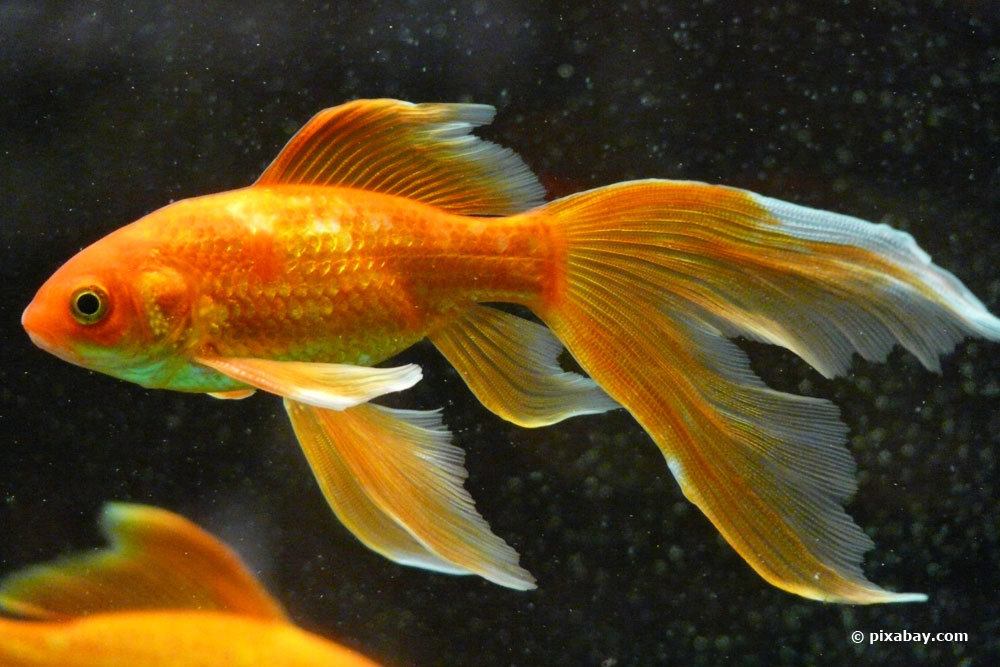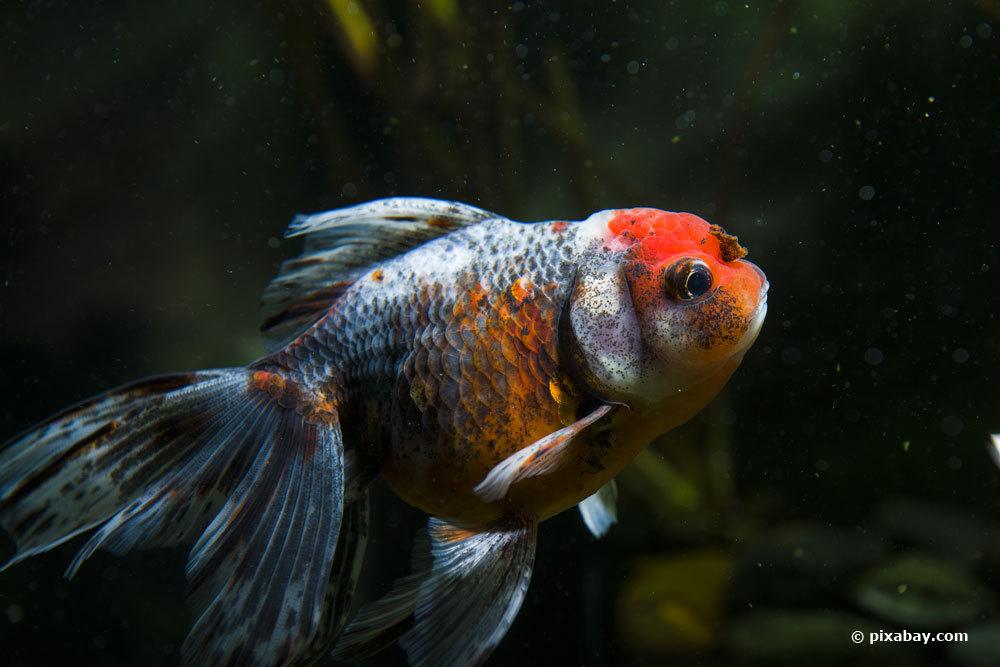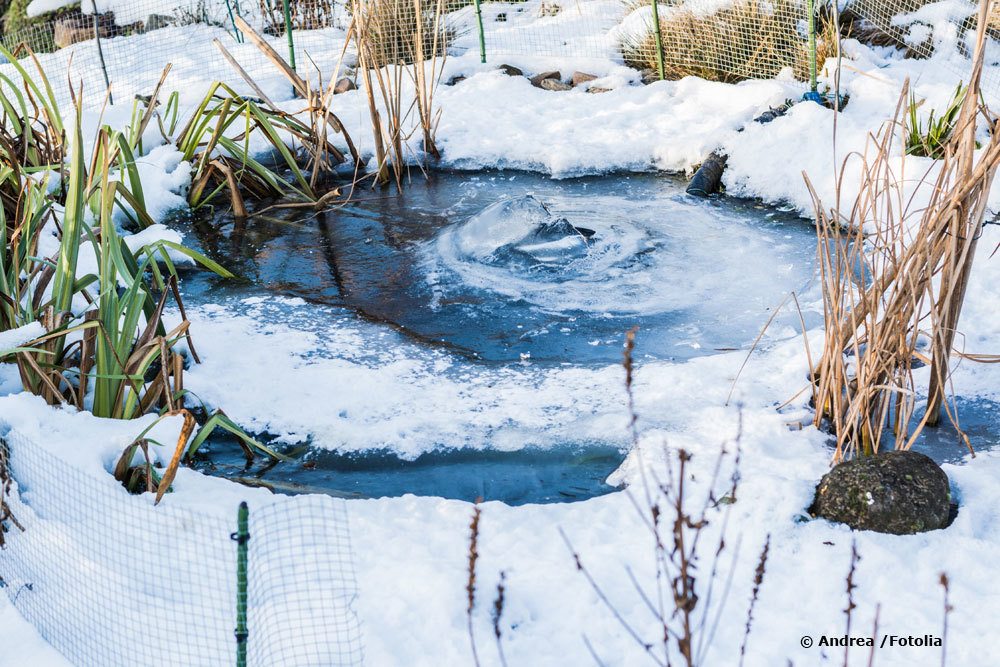A fish pond can be found in countless ornamental gardens, front gardens and other outdoor facilities. One of its favorite inhabitants is the goldfish. Among the countless species of goldfish, the veiltail occupies a special place because of its particularly handsome tail fin. We explain how to keep the veiltail in your home pond and offer a clear guide to everything you need to know about settlement and the basics of keeping them.
Contents
General needs
Whether in a garden pond, aquarium, or natural body of water, the Carassius Auratus goldfish, the veiltail, requires some general environmental conditions for long-term survival:
- Low water temperature between 4 °C and 22 °C.
- Ideally clean, oxygen-rich water with low levels of suspended solids and other impurities
- pH value of the water between 6.5 and 8.3
- Nitrate content of the water maximum 25 mg/l
- Hardness of the water 10 to 12 dH
- Water depths around 100 to 150 centimeters
Intensively sunlit waters possible without any problems, as long as there is about 30% shaded water surface, e.g. in shore zones.
bottom of water made of loose sand and gravel mixture
life form as schooling fish, group sizes at least 4 to 6 animals

Optimal habitat
If one knows now already the general requirements of the animals of the genus veiltail to their habitat, these bases can be created easily in form of a suitable garden pond, in which one can hold the animals without considerable problem:
- Pond volume at least 1000 liters, for large numbers of animals correspondingly higher.
- Minimum depth 100 to 150 centimeters, in case of exposed location due to winter freezing provide for greater depths
- Provide shaded water areas, e.g. by aquatic plants, vegetated edge areas with overhanging vegetation, or surrounding trees.
- Select a predominantly sandy or gravelly pond substrate; too much soil is detrimental due to “contamination” of the pond water by nutrients and suspended particles.
- Good filter performance for high water quality, mechanical or natural filter (filter gravel, reed zone etc.) possible
- Water quality as already described, if necessary check pH-value and nitrate content by test strips and correct if necessary (pH-lifter / -lowering agent, nitrate binder etc.)
Breeding
Similar to countless other ornamental fishes, today there exist numerous different, partly strongly overbred forms of the original veiltail goldfish. Especially the extremely outbred varieties can be kept in the limited environment of a garden pond only with many disadvantages.
This is because the intensive selection in the breeding process means that many positive characteristics in terms of hardiness, adaptability and husbandry are generally neglected in favor of purely visual considerations. It therefore makes sense to revert to one of the original, less modified forms of the veiltail:
Fan-tails
- Also called “Western Ryukin” because of its distribution in western countries.
- Strong tapering of the caudal fin, veil shape correspondingly less intensely pronounced
- Uncomplicated in terms of reproduction in the garden pond
- Body sizes up to 20 centimeters possible
- Attention: The fantails show less variability with regard to water temperature. Although they can also overwinter without problems, the water temperature should not be below 13 °C during the active phases.
Ryukin
- is considered the oldest breeding form of the veiltail
- very good suitability for keeping in garden pond
- high dorsal shield with double fin
- very broad body appearance
- good overwintering abilities
- fast swimmer, therefore higher space requirement

Calico
- very original, little one-sided breeding form
- elongated body, similar to classic goldfish
- characteristic pattern with white, black and red-orange spots
- one of the most adapted breeding forms for pond keeping

Tip: The closer a breeding form of the veiltail goldfish is to the “original” goldfish, the more robust and adaptable it usually is. With this background knowledge, even beginners in keeping and breeding goldfish can easily avoid reaching for completely unsuitable forms of Carassius Auratus.
Suitable co-inhabitants
Since hardly any garden pond should be reserved for one life form alone, the question sometimes arises as to which other animals harmonize well with the veiltail goldfish. Since this goldfish prefers relatively cool water, it is difficult to combine with most of the established other pond fish species. Although the animals leave each other in peace, due to their different preferences, in many cases the conditions for coexistence are not met. Therefore, known and widespread association of the fantail is only with a few fish species that are also cold-loving:
- Minnow
- bitterling
Problems with compatibility with plants and other pond inhabitants, such as mussels or snails, are not known. As long as sufficient free water volume is maintained, nothing stands in the way of planting the pond.
Note: Unsuitable for keeping together with the veiltail is the common goldfish. The latter prefers the same general conditions, but is superior in its swimming characteristics. In the long run, it will therefore displace the veiltail in terms of food and preferred habitat.
Settlement
If the conditions in the pond are right and the other participants in the planned community have been found, the veiltail may move in. The optimal time to move in is spring, as this gives the generally rather sensitive animals enough time to acclimatize to the new habitat before the most difficult phase, overwintering. A slow acclimation of the new inhabitants usually succeeds very well and without too much stress for the fish with the following procedure:
- Wait for a minimum water temperature of 15 °C
- Place the transport bag with the fish, initially sealed, at the edge of the pond.
- After approx. 45 to 60 minutes, open the bag, fill in some pond water and close it again.
- Wait another 30 minutes, then open the bag and let the fish swim out on their own.

Feed
Although the goldfish is capable of finding its own food, the food supply is severely limited in the limited volume of the garden pond. Thus, the external supply of food is indispensable. Since the veiltail also accepts almost all types of food and seems to accept offered food at any time, especially beginners in pond fish are in danger of overfeeding. The result is overweight animals with a reduced life expectancy. The sluggish swimming behavior also makes them an easy target for predators, such as birds, cats and martens. Foods well suited for the veiltail include:
- Pre-prepared fish food from specialty stores, available mostly as dry food, frozen food, or live food.
- Leaves of lion’s tooth or lamb’s lettuce as a food supplement and as a distraction from existing water plants
- Peas, corn and potatoes as additions to the other food
The following procedures have proven to be effective for the animals and the pond:
- Feeding only from a water temperature of 10 °C, below which the activity of the animals is too low.
- Distribute the feed into two to three smaller doses per day, as a single dose results in a high proportion of unused food, which is a burden on the pond water.
- Make one day per week free of food
Alternate different feeds in order to provide the animals with a comprehensive supply and to keep them occupied through variety in the food offered
Tip: Water fleas are considered the live food of all for the veiltail. The advantage of live food is that uneaten animals live on in the water and are eaten later. Dead food, on the other hand, sinks to the bottom of the pond and decomposes into water pollutants.
How much food?
While determining the right type of food is quite easy, determining the right amount of food is much more difficult. It can vary greatly depending on the activity, size and number of animals. Here it is recommended to observe the pond closely at the beginning. If food remains in the pond, the amount should be reduced. If everything is eaten, the amount can be increased slightly. Finally, a balance between supply and consumption should be achieved.
Propagate
Ideally, the veiltail will begin to self-reproduce and reproduce after becoming acclimated to the pond. This maintains the population and eliminates the need for repeat purchases of new animals. The beauty is that the veiltail goldfish does not need any guidance to reproduce. If the environmental conditions are right, it will start reproducing on its own in the spring. The presence of overgrown, shallow pond zones for egg laying is especially important here. About one week after egg laying, one to two millimeter large young hatch in black camouflage. Only after about 12 months do they develop the typical tail fin and the distinctive body coloration.
Attention: The biggest problem with the reproduction of this goldfish is cannibalism! Therefore it is recommended to take the freshly hatched animals and raise them separately in a tank or aquarium. Only from a body size of about four centimeters the danger of being eaten by older animals is passé and the young animals can be returned to the pond.
Safe hibernation
Once the first summer has passed, the animals prepare for hibernation in the pond. They retreat to the lower water layers with decreasing water temperatures and remain there in a dormant state. As a pond owner, you can support this hibernation process by creating the right conditions:
- Cut back green plants and protect pond with netting against foliage to avoid putrefactive gases caused by decomposition in the water.
- Install an ozonizer at the bottom of the pond to ensure sufficient oxygen supply for the fish.
- Provide ice freeze at the surface to avoid complete freezing (removal of putrefactive gases from the water)
- When the temperatures rise again in spring, the fish leave their winter quarters independently and return to the active phase. From this time on, feeding should be resumed and a pump should be used to provide the necessary circulation in the pond.
Diseases and parasites
Carassius Auratus has hardly any typical, species-specific diseases. Only the intestinal blockage, which is always observed in fish due to a particularly one-sided diet, occurs more quickly and more frequently in this fish due to its physiological characteristics. Otherwise, it suffers from the generally known fungal, bacterial and parasitic diseases that can generally occur in ponds and aquariums.
The best countermeasure is to provide a sufficiently large pond and ensure good water quality to make conditions as poor as possible for pathogens to develop and spread from the outset.
Tip: Observe your pond fish regularly to detect changes in behavior and appearance early on. Both can be a sign of a disease and thus the starting signal for a successful control.

